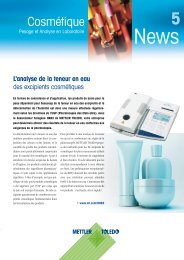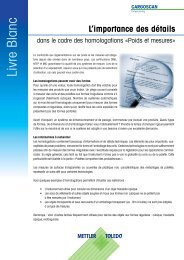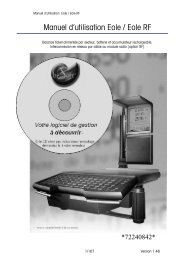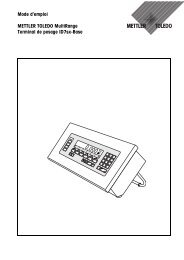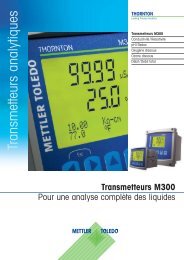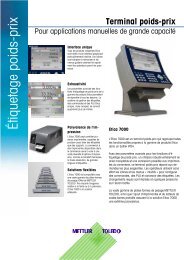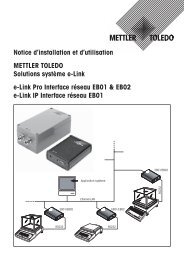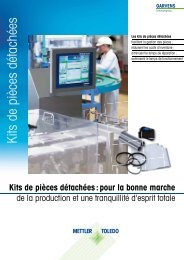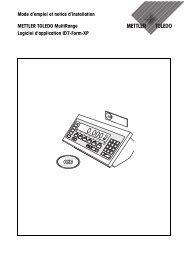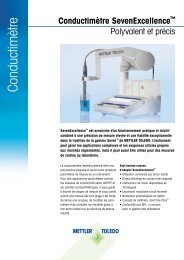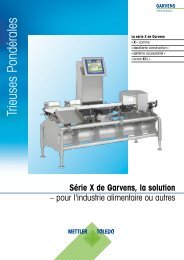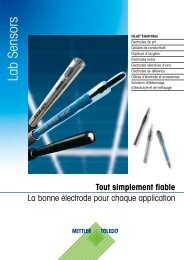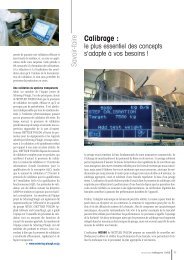Mode d'emploi Logiciel Calibry pour le calibrage de pipettes
Mode d'emploi Logiciel Calibry pour le calibrage de pipettes
Mode d'emploi Logiciel Calibry pour le calibrage de pipettes
You also want an ePaper? Increase the reach of your titles
YUMPU automatically turns print PDFs into web optimized ePapers that Google loves.
Définir <strong>de</strong>s <strong>pipettes</strong><br />
24<br />
Étape 2: Définir un modè<strong>le</strong> <strong>de</strong> pipette<br />
Dans la <strong>de</strong>uxième fenêtre <strong>de</strong> l’assistant <strong>de</strong> <strong>pipettes</strong>, vous définissez<br />
<strong>le</strong> type <strong>de</strong> pipette. Cliquez sur la flèche à côté <strong>de</strong> la désignation<br />
<strong>de</strong> modè<strong>le</strong>, <strong>pour</strong> afficher une liste <strong>de</strong> tous <strong>le</strong>s modè<strong>le</strong>s <strong>de</strong> pipette<br />
disponib<strong>le</strong>s.<br />
Les champs en <strong>de</strong>ssous <strong>de</strong> la désignation <strong>de</strong> modè<strong>le</strong> montrent<br />
<strong>de</strong>s informations supplémentaires sur <strong>le</strong> modè<strong>le</strong> <strong>de</strong> pipette sé<strong>le</strong>ctionné.<br />
Si aucun <strong>de</strong>s modè<strong>le</strong>s <strong>de</strong> pipette disponib<strong>le</strong>s ne correspond à votre<br />
nouvel<strong>le</strong> pipette, cliquez sur <strong>le</strong> bouton “Type editor” <strong>pour</strong> créer un<br />
nouveau modè<strong>le</strong> <strong>de</strong> pipette.<br />
Dans la liste, sé<strong>le</strong>ctionnez un modè<strong>le</strong> <strong>de</strong> pipette qui est <strong>le</strong> plus<br />
proche du nouveau modè<strong>le</strong> à créer puis cliquez sur <strong>le</strong> bouton “Add<br />
new”. Les paramètres du modè<strong>le</strong> sé<strong>le</strong>ctionné peuvent être édités<br />
dans la partie inférieure <strong>de</strong> la fenêtre:<br />
Type:<br />
Description:<br />
Manufacturer:<br />
Channels:<br />
Range:<br />
ISO Class:<br />
Désignation <strong>pour</strong> <strong>le</strong> nouveau modè<strong>le</strong> <strong>de</strong><br />
pipette.<br />
Description <strong>pour</strong> <strong>le</strong> nouveau modè<strong>le</strong> <strong>de</strong><br />
pipette.<br />
Fabricant <strong>de</strong> ce modè<strong>le</strong> <strong>de</strong> pipette.<br />
Nombre <strong>de</strong> canaux <strong>de</strong> ce modè<strong>le</strong> <strong>de</strong> pipette.<br />
Dans la liste, sé<strong>le</strong>ctionnez la plage qui correspond<br />
au nouveau modè<strong>le</strong> <strong>de</strong> pipette.<br />
i aucune plage correspondante n’est disponib<strong>le</strong>,<br />
cliquez sur <strong>le</strong> bouton “Range editor”,<br />
<strong>pour</strong> définir une nouvel<strong>le</strong> plage: Cliquez sur <strong>le</strong><br />
bouton “Add new” an. Dans <strong>le</strong>s <strong>de</strong>ux champs<br />
“min” et “max”, entrez <strong>le</strong> volume minimal et<br />
<strong>le</strong> volume maximal <strong>de</strong> la pipette en question<br />
et l’unité correspondante. Cliquez sur “Save”<br />
<strong>pour</strong> mémoriser la nouvel<strong>le</strong> plage.<br />
Ensuite apparaît à nouveau la fenêtre “Pipette<br />
Type” et la nouvel<strong>le</strong> plage peut être<br />
sé<strong>le</strong>ctionnée dans la liste.<br />
Classe selon ISO 8655 <strong>pour</strong> ce modè<strong>le</strong> <strong>de</strong><br />
pipette. Si <strong>le</strong> modè<strong>le</strong> <strong>de</strong> pipette ne correspond<br />
à aucune classe selon ISO 8655 ou<br />
que vous ne la connaissez pas, sé<strong>le</strong>ctionnez<br />
“Unknown”.<br />
Si vous <strong>le</strong> souhaitez, vous pouvez entrer dans la zone “Manufacturer<br />
specifications (optional)” <strong>le</strong>s spécifications d’essai que <strong>le</strong><br />
fabricant a défini <strong>pour</strong> ce modè<strong>le</strong> <strong>de</strong> pipette. Les données entrées<br />
peuvent être sé<strong>le</strong>ctionnées lors du <strong>calibrage</strong> comme base <strong>pour</strong> une<br />
métho<strong>de</strong> d’essai. Si vous n’indiquez pas <strong>de</strong> spécifications d’essai,<br />
vous pouvez <strong>le</strong>s définir lors du calibrge <strong>de</strong> la pipette.<br />
Vous pouvez définir jusqu’à 4 volumes d’essai. Si ceux-ci ne sont<br />
pas déjà activés, cliquez sur <strong>le</strong>s boutons marqués avec “x”. Sé<strong>le</strong>ctionnez<br />
d’abord l’unité <strong>de</strong> volume (“Volume unit”) voulue puis<br />
entrez <strong>le</strong> volume d’essai ainsi que <strong>le</strong> “Systematic error” et “Random<br />
error” (explication, voir plus bas).



